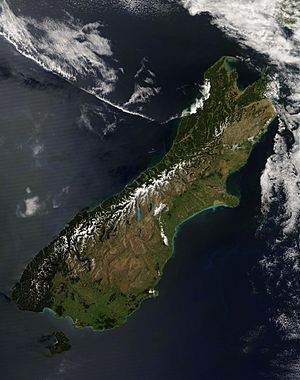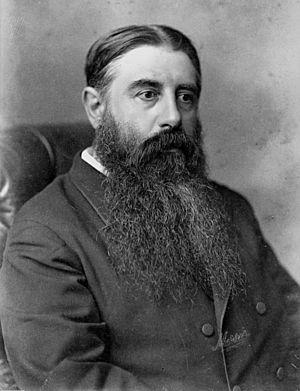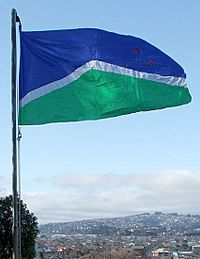South Island nationalism facts for kids
South Island nationalism is an idea that some people in the South Island of New Zealand believe in. It's the idea that the South Island should be its own country or have much more control over its own decisions, separate from the North Island. This idea isn't very popular. For example, in the 1999 election, a political party called the NZ South Island Party only got a very small number of votes.
Back in 1868, Julius Vogel, who later became the 8th Premier (like a prime minister) of New Zealand, often spoke about separating the North and South Islands. This even led to him being fired from his job at the Otago Daily Times newspaper. In 1865, the New Zealand Parliament even voted on the idea of independence for the South Island. One big reason the capital of New Zealand was moved from Auckland to Wellington in the same year was to keep the South Island from wanting to become a separate colony. Wellington was seen as more central to both islands.
Contents
History of the South Island
Māori Times
For a long time, the different Māori iwi (tribes) who settled the South Island – like the Waitaha, the Ngāti Mamoe, and Ngāi Tahu – were politically independent from the tribes in the North Island. In the 1830s, the Ngāti Toa tribe from the Kapiti Coast in the North Island tried to take over the South Island. But an alliance of southern chiefs from Otautahi and Murihiku fought them off. By the time the first European settlers arrived in the South Island (which Māori called Te Waipounamu) in the early 1840s, the Ngāti Toa only controlled a small area called the Wairau plains.
This history of independence from North Island tribes still affects South Island Māori culture today. For example, during Waitangi Day celebrations in 2010, the Ngāi Tahu tribe chose not to fly the Tino Rangatiratanga flag, saying it had caused "nothing but trouble."
European Arrival and British Rule
The first Europeans known to reach the South Island were the crew of Dutch explorer Abel Tasman. They arrived in December 1642 in their ships Heemskerck and Zeehaen. Tasman anchored in Golden Bay but left after a fight with local Māori. He drew maps of parts of New Zealand's west coast and named the islands Staten Landt. Later, Dutch mapmakers changed the name to Nova Zeelandia, which came from the Dutch province of Zeeland. This name was later changed to New Zealand by British naval captain James Cook when he visited the islands in 1769–1770.
In 1840, Britain officially took control of New Zealand. This happened because the New Zealand Company was trying to start its own separate colony in Wellington, and the French also had claims in Akaroa. So, Lieutenant-Governor William Hobson declared that Britain ruled all of New Zealand on May 21, 1840. The North Island was claimed by the Treaty of Waitangi, and the South Island by discovery.
New Munster Province

In 1841, New Zealand became its own colony, separate from New South Wales (Australia). A special document called a Royal Charter said that the main islands would now be called 'New Ulster' (the North Island), 'New Munster' (the South Island and the southern part of the North Island), and 'New Leinster' (Stewart Island). At first, these names were just for geography, and the whole colony was run from Auckland. New Munster included the South Island and the North Island up to the Patea River.
Things changed in 1846 when the New Zealand Constitution Act 1846 divided the colony into two provinces: New Ulster Province (the North Island) and New Munster Province (the South Island and Stewart Island). Each province had its own leader, called a Lieutenant-Governor, and groups that made and carried out laws. In 1848, Edward John Eyre became the Lieutenant-Governor of New Munster. By 1851, people in the provinces were allowed to elect some of the members of their law-making groups.
The New Munster Provincial Council only met once, in 1849, because settlers in Wellington strongly criticized it. Governor George Grey understood these concerns. He suggested that new law-making councils should be set up in each province, with most members elected by people who had the right to vote. However, before these new councils could meet, the United Kingdom Parliament passed the New Zealand Constitution Act 1852.
This Act ended the New Ulster and New Munster provinces in 1853, after only seven years. New Munster was then divided into the provinces of Canterbury, Nelson, and Otago. When the New Zealand Parliament was created, James Macandrew, the leader of Otago Province, felt that the central government was unfair to Otago. Other provinces felt this too, but Otago was especially wealthy because of the gold rush in 1861, so they felt the unfairness more strongly.
The Provincial Period
From 1853 to 1876, during the time of the provinces, the North Island was dealing with the New Zealand Wars. But the South Island, with fewer Māori people, was mostly peaceful. The southern provinces grew much faster than those in the north. In 1861, gold was found at Gabriel's Gully in Central Otago, which started a big gold rush. Dunedin became the richest city in New Zealand. Many people in the South Island didn't like paying for the North Island's war and didn't want to be told what to do by a central government. The Otago Colonist newspaper said it was "the sad but inevitable result of joining by artificial bonds of union countries that Nature (by Cook Strait) designed should be separate."
Julius Vogel, who was the editor of the Otago Colonist, argued that Otago was much further from the capital of Auckland than it was from Victoria or Tasmania in Australia. He looked forward to "a glorious future – the separation of the two islands." In 1862, a large public meeting supported the idea of separation. However, Southland (which had just become separate from Dunedin) and Canterbury (which knew Dunedin wanted to be the South Island's capital) were not very keen on the idea.
A group called the "Southern Separation League" was formed. But Vogel soon realized that the provincial system was failing. He saw that the weaker provinces were running out of money, so he decided to support a strong central government instead. He even moved to a northern area to run for election there.
In 1865, Auckland joined with Otago to try and get both islands to become independent. They lost the vote. In the same year, because of the South Island's concerns, the colonial government moved the capital from Auckland to Wellington. By 1870, only Canterbury and Otago were doing well.
The Modern Era
In 2006, an article in the New Zealand Listener magazine suggested that the South Island independence movement might be starting up again.
In 2007, Richard Prosser suggested that the South Island should have its own Parliament as part of a New Zealand Confederation (a group of states or provinces working together). Mr. Prosser later became a list MP (a type of elected official) for the New Zealand First party in the 2011 general election. Several groups on the internet also support an independent South Island.
The March 2010 issue of North & South magazine had an article called "The Great Divide." It explored the differences in geography, culture, and language between the North and South Islands.
South Island Identity
Anna Rogers, a writer from Christchurch, once said that the "South Island identity is based on the kinder, cheaper, less-harried lifestyle of the South Island, as compared, most notably, with Auckland." The idea of the "Southern man" (a tough, practical person from the South Island) is still a well-known character throughout New Zealand.
Groups Supporting South Island Independence
- The NZ South Island Party was a political party created to get more representation for the South Island. They ran in the 1999 election but didn't win any seats. The party was officially closed in 2002.
- South Island First is a political pressure group (a group that tries to influence politics) that brings together people who support the South Island having more control over itself. Because they focus on this one issue, members can belong to any political party or none. They put aside other political discussions to unite the movement for self-determination.
- The New Munster Party was a political party created in 2010. It wanted to create an independent Republic of New Munster. Its goal was to give New Munster the tools it needed to grow economically, socially, culturally, and politically. They hoped for regional independence, similar to places like Scotland, or even full independence, like Ireland.
- The South Island Independence Movement (S.I.I.M) is a current group that wants the South Island to become a separate, independent nation from New Zealand. This group was founded and is currently led by Solomon Tor-Kilsen.
Flag Ideas for the South Island
New Zealand is a unitary state, which means it has one central government rather than separate states or provinces. Because of this, there are no official flags for the North or South Islands (except for the national flag). However, three different designs have been suggested privately for a South Island flag.
James Dignan's Idea
Flag expert James Dignan suggested a flag that includes the Southern Cross stars, which are also on the New Zealand national flag. His design also shows the Southern Alps (the white peak) and the green forests and fields of the south. The Southern Alps are the South Island's most famous mountains, and farming and forestry are important industries there, so this flag represents the island well.
Dean Thomas' Idea
Dean Thomas proposed a flag that looks like early Māori flags. In his design, the white background stands for the snow of the Southern Alps. The red stripe represents the people, both Māori and European. The New Zealand White Ensign (a type of flag) is placed in the top left corner, blending with the white background. Te Wai Pounamu is the Māori name for the South Island.
The New Munster Cross
The New Munster Cross is promoted by the group South Island First and the New Munster Party. It has a Nordic Cross design. The white background represents the Southern Alps, a green cross represents the rich forests and farmland of the South Island, and blue represents the ocean.







